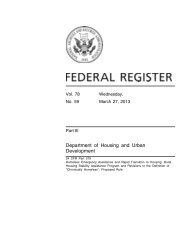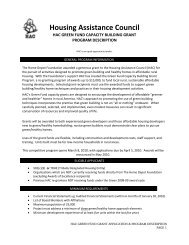Public Relations Guide for Rural Housing Organizations (manual
Public Relations Guide for Rural Housing Organizations (manual
Public Relations Guide for Rural Housing Organizations (manual
Create successful ePaper yourself
Turn your PDF publications into a flip-book with our unique Google optimized e-Paper software.
For example, at Lee County Community Development Corporation (LCCDC) in Arkansas thedirector was the spokesperson <strong>for</strong> the media. Since the director was often not available,however, an assistant was her backup. A third staff member was trained to be the assistant’sbackup; having a backup <strong>for</strong> every procedure was general office practice <strong>for</strong> LCCDC.Consistency is important when establishing an image. This supports the argument <strong>for</strong> havingone staff person in charge of public affairs. Failing this, an organization could use the personclosest to the individual project in question, so long as the same person from each project talksto all the press.The designated communications person should have good writing and interpersonal skills aswell as the ability to follow through. Writing skills are so basic to PR work that LindaNetherton, director of a housing group in Hillsboro, Ore., has advised that nonprofitorganizations recruit people with journalism experience to serve on their committees andboards of directors, or to become volunteers <strong>for</strong> their organization.More likely than not, the job of coordinating public relations involves the ability to juggleseveral tasks simultaneously. As with any public reflection on your organization, quality ismore important than quantity. Judicious use of time and good groundwork will reflect yourorganization’s serious commitment to furthering your public presence.The communications person should be able to establish ongoing relationships with mediapeople; do not make a summer intern the centerpiece of your PR strategy. This person shouldhave a personal commitment to the organization and to the work that you do. Temporary staffsuch as interns or volunteers (e.g., members of AmeriCorps) can be called upon to do the timeconsumingtasks of public relations – mailings or contacts that do not require answeringdetailed questions. On the other hand, there is a side benefit from using well-chosen volunteersto be interviewed on behalf of your organization; they are usually enthusiastic and inspire yourcommunity’s participation in your organization.If your community is bilingual, it may be helpful <strong>for</strong> the communications person to bebilingual. Otherwise a designated volunteer or assistant to the communications person cananswer basic questions over the telephone in the second language.EquipmentIt is more important to have quality PR personnel than to have state-of-the-art equipment. Thisguide addresses issues such as Internet access and web sites in subsequent sections, but itshould be noted that no matter what your budget is or what equipment your organization hasat its disposal, nothing is as fundamental to public relations work as human energy.Identify Your <strong>Public</strong> <strong>Relations</strong> Objectives.Have a brainstorming session with people from your staff or board who are interested in publicrelations or have PR experience to discuss how you want your organization, issues/programs,and community perceived.<strong>Housing</strong> Assistance Council 7









